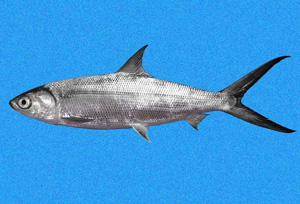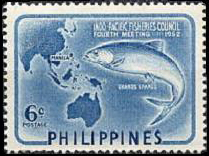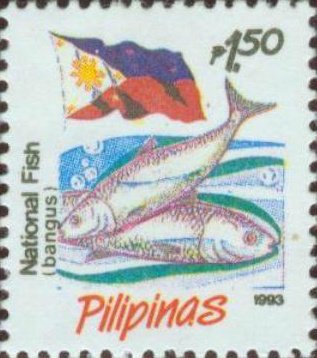
(discoverlife.org)
Phylum: Chordata Haeckel, 1874
Subphylum: VertebrataLamarck J-B., 1801
Classe: Actinopterygii Klein, 1885
Ordine: Gonorynchiformes Regan, 1909
Famiglia: Chanidae Günther, 1868
Genere: Chanos Lacepède, 1803
Italiano: Cefalone
English: Milkfish
Français: Poisson-lait, Chano
Deutsch: Milchfisch
Español: Sabalote, Pez-de-leche
Descrizione
È l'unico rappresentante della famiglia Chanidae, è un pesce osseo marino, ma non è insolito ritrovarlo in zone d'acqua dolce e salmastra. L'aspetto di questo pesce è affusolato e idrodinamico, con una coda estremamente forcuta, da buon nuotatore. La livrea è bianco argentea, con pinne orlate di nero, o comunque scure. Raggiunge una lunghezza di 1,7 m ma solitamente si pescano esemplari da 1 metro. Si ciba di alghe e invertebrati, non possedendo denti. L'accoppiamento e la deposizione avvengono nelle barriere coralline dove le larve crescono per 2-3 settimane, fino a quando diventano avannotti: allora migrano verso le coste a mangrovia e negli estuari (non disdegnando i laghi costieri e le lagune). Una volta raggiunta la maturazione sessuale torneranno nei reef corallini a riprodursi. Nel sudest asiatico e in molti paesi d'origine alla pesca tradizionale si affianca la pesca per alimentare gli allevamenti: avannotti e le larve dei pesci latte sono pescati lungo le coste, gli stagni e le lagune e trasportati in questi grandi allevamenti, dove saranno poi fatti crescere nelle misure desiderate e avviati alla consumazione (congelati, freschi, sott'olio o affumicati). Il Chanos chanos è l'unica specie superstite della famiglia, dopo che sette specie (raggruppate in 5 generi) si sono estinte (e ritrovate oggi come fossili). Tra le forme fossili più note vi sono Chanoides, Coelogaster e Caeus.
Diffusione
Questo pesce è diffuso nell'oceano Indiano e nell'oceano Pacifico, in tutte le acque con temperatura superiore a 20 °C e vicine alle coste. Particolarmente diffuso nella zona tra le Maldive e le Galápagos, ma localizzato anche nelle coste malgasce e nel Mar Rosso.
Sinonimi
= Butirinus argenteus Jerdon, 1849 = Butirinus maderaspatensis Jerdon, 1849 = Chanos arabicus Lacepède, 1803 = Chanos chloropterus Valenciennes, 1847 = Chanos cyprinella Valenciennes, 1847 = Chanos gardineri Regan, 1902 = Chanos indicus van Hasselt, 1823 = Chanos lubina Valenciennes, 1847 = Chanos mento Valenciennes, 1847 = Chanos mossambicus Peters, 1852 = Chanos nuchalis Valenciennes, 1847 = Chanos orientalis Valenciennes, 1847 = Chanos salmoneus Forster, 1801 = Chanos salmonoides Günther, 1879 = Cyprinus pala Cuvier, 1829 = Cyprinus palah Cuvier, 1829 = Cyprinus tolo Cuvier, 1829 = Leuciscus palah Cuvier, 1829 Small text. = Leuciscus salmoneus Forster, 1801 = Leuciscus zeylonicus Bennett, 1833 = Lutodeira chanos Forsskål, 1775 = Lutodeira chloropterus Valenciennes, 1847 = Lutodeira indica van Hasselt, 1823 = Lutodeira mossambica Peters, 1852 = Lutodeira mossambicus Peters, 1852 = Lutodeira salmonea Forster, 1801 = Mugil chanos Forsskål, 1775 Small text. = Mugil salmoneus Forster, 1801.
Bibliografia
–Freyhof, J.; Sparks, J.S.; Kaymaram, F.; Feary, D.; Bishop, J.; Al-Husaini, M.; Almukhtar, M.; Hartmann, S.; Alam, S. & Al-Khalaf, K. (2017). "Chanos chanos". IUCN Red List of Threatened Species. 2017.
–Eschmeyer, W. N.; R. Fricke, eds. (4 January 2016). "Catalog of Fishes". California Academy of Sciences. Retrieved 25 January 2016.
–Froese, Rainer, and Daniel Pauly, eds. (2015). "Chanidae" in FishBase. October 2015 version.
–Nelson, J. S. (2006). Fishes of the World (4th ed.). Hoboken, NJ: John Wiley & Sons. pp. 135-136. ISBN 978-0-471-25031-9.
–Pangilinan, Jr., Leon (3 October 2014). "In Focus: 9 Facts You May Not Know About Philippine National Symbols". National Commission for Culture and the Arts. Retrieved 8 January 2019.
–Froese, Rainer and Pauly, Daniel, eds. (2015). "Chanos chanos" in FishBase. October 2015 version.
–Atbp (2017-01-20). "Kilawin na Bangus (Milkfish Ceviche)". ATBP. Retrieved 2020-03-24.
–Hiufu Wong, Maggie. "40 of the best Taiwanese foods and drinks". www.cnn.com. CNN. Retrieved 29 September 2020.
–"Chanos chanos (Forsskal, 1775)". Cultured Aquatic Species Information Programme. FAO Fisheries and Aquaculture Department.
–"Milkfish (Bangus) Breeding and Fry Hatchery Technology". Archived from the original on 2013-12-13. Retrieved 2010-09-12.
–Milkfish (Bangus) Breeding and Fry Hatchery Technology.
–"Aquaculture Profile of Chanos chanos".
–Lee, C.-S.; Leung, P.-S.; Su, M.-S. (1997). "Bioeconomic evaluation of different fry production systems for milkfish (Chanos chanos)". Aquaculture. 155 (1-4): 367-376.
–Gapasin, R.S.J; Bombeo, R; Lavens, P; Sorgeloos, P; Nelis, H (1998). "Enrichment of live food with essential fatty acids and vitamin C: effects on milkfish (Chanos chanos) larval performance". Aquaculture. 162 (3-4): 269-286.
–FitzGerald, William J. (2004). Milkfish aquaculture in the Pacific: potential for the tuna longline fishery bait market (PDF). Noumea, New Caledonia: Secretariat of the Pacific Community.
–"Fisheries bureau releases golden milkfish".
–"Plan to breed 'golden' bangus dies with lone specimen".
–Francisco José Poyato-Ariza, A revision of the ostariophysan fish family Chanidae, with special reference to the Mesozoic forms (Verlag Dr. Friedrich Pfeil, 1996).
–Bagarinao, T., 1994. Systematics, distribution, genetics and life history of milkfish, Chanos chanos. Environ. Biol. Fish. 39(1):23-41.

|
Data: 23/10/1952
Emissione: Congresso sulla pesca Stato: Philippines Nota: Emesso in una serie di 2 v. con colori e valori diversi ma vignetta eguale |
|---|

|
Data: 09/07/1993
Emissione: Bandiera delle Filippine e simboli nazionali Stato: Philippines |
|---|

